#Fujifilm X-Mount
Explore tagged Tumblr posts
Text
Dave Etchells interviews Sigma CEO about lens design, good news for Fujifilm users
Dave Etchells of Imaging Resources, one of our favourite digital imaging websites until it recently shut down, has released another excellent interview on PetaPixel, this time with the CEO of Sigma, Kazuto Yamaki. Image courtesy of Sigma. We’ve been hoping that Sigma would add more X-mount lenses to its new and growing collection of lenses for Fujifilm X-mount cameras, and it appears that this…
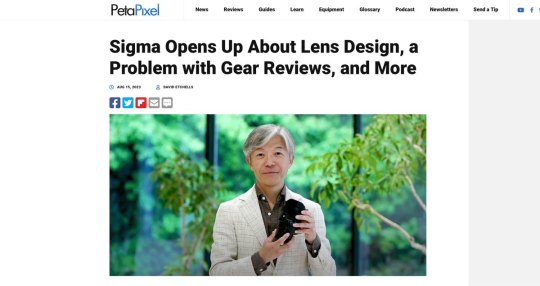
View On WordPress
#Fujifilm#Fujifilm X-Mount#Kazuto Yamaki#Sigma#SIGMA 16mm F1.4 DC DN | Contemporary#SIGMA 30mm F1.4 DC DN | Contemporary#SIGMA 56mm F1.4 DC DN | Contemporary#Sigma Corporation#SIGMA Corporation of America
0 notes
Photo
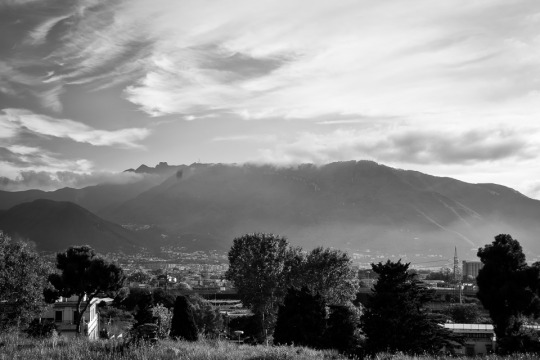
Pompeii
#2022#Cloudy#Explore#Foggy#Fujifilm X-Pro 2#Landscape#Misty#Mount Vesuvius#November#Fujifilm#Light#BW#BNW#Blackandwhite#Landscapephotography#Documen#black whip#Black&Whte#Monochrome#Atmosphere#Mountain#Volcano#history#i talk sometimes#Archeology#Lens#50mm#Print#Printshop#View
14 notes
·
View notes
Audio
(Liam Photography Podcast)
0 notes
Text


Night Sky... Space color. Фотографию все на: Fujifilm xt-4, а объектив: x-mount 16-55.
13 notes
·
View notes
Text
I went Full-Fuji! (GFX One Year Review)
One year ago, I decided to ditch my Nikon DSLRs for a Fujifilm GFX 50R.
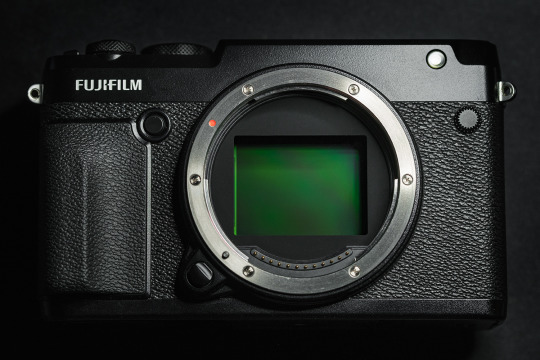
The GFX's sensor is larger than a full-frame sensor with a crop factor of 0.79
A little over a year ago, I still was using a few Nikon DSLRs to do just about anything. For portraits and landscape, I had a very respectable D810. Enough megapixels to provide some room for cropping and a decent dynamic range for most situations. For action and hobby-wildlife I had a D500. A durable mini-tank with performance that to this day would be hard to dismiss even in the light of mirrorless flagship innovation.
However, the question of my camera-future slowly crept into my mind. Was it time to change and upgrade into the Nikon Z system? Switching to a Z7 would indeed have been a sensible move, adapting older lenses while getting the sensor of the D850 in a smaller, cheaper body with an ecosystem of native lenses with the optical quality up to specs for the next decade. On paper and elsewhere, it should have been the obvious choice. Yet my answer to this question was a resounding "no" and I went against reason to set my sights on a Fujifilm GFX 50R. I took that model over the S because I enjoy the rangefinder form factor.
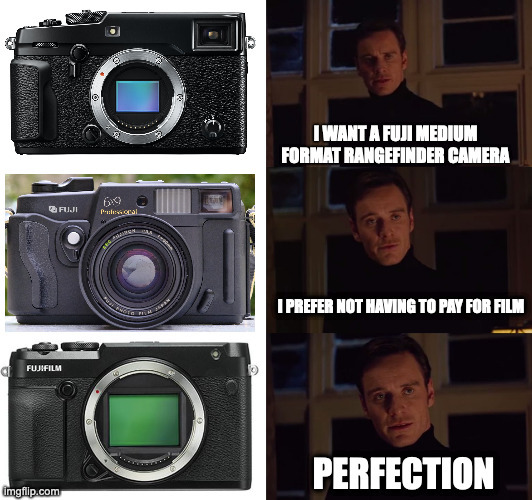
In hindsight, the smartest of all moves would probably have been to remain with what I had, adhering to the ancient photographic wisdom: "lenses are more important than cameras". My kits could have kept me satisfied for probably another 10 years if we are being honest. I could have stayed within the F mount ecosystem and could have taken advantage of its downright insane price drops to get top-of-the-line lenses for peanuts instead of selling the farm on a whim, however carefully considered it might have been.
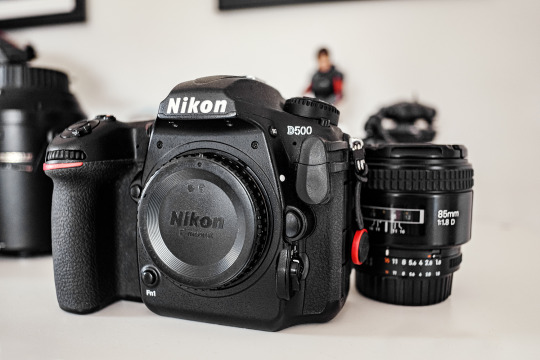
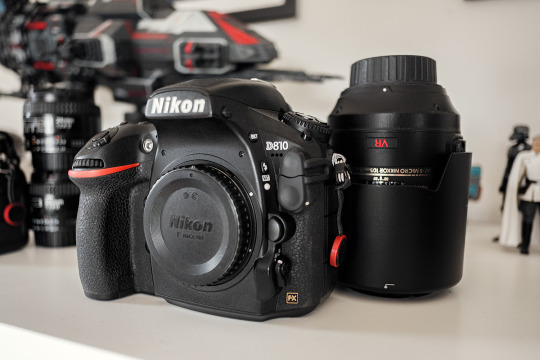
These old and trusty Nikon DSLRs got sold off to finance the 50R
The truth is that after fifteen years of walking the beaten paths camera-wise, I wanted to shake things up. I longed for a change of pace. I felt confident enough in my practice to know what type of photography I would want to engage in for the foreseeable future. I also felt confident enough that I'd be able to answer the call of the occasional assignment using a camera system that would have a non-negligible amount of drawbacks. The challenge even seemed like a fun new variable to add to contracts. Thus, the choice I made for my photographic future has been one born out of love rather than made from a place of reason.
When I think of good photographic memories involving the process — how photography is approached with mind and body — I immediately have two very different ideas jumping to mind and each has an ideal type of tool that best suits it. Neither of these are about efficiency. Neither of these are about performance beside niche-performance, perhaps. But that, is more of an acquired taste and it also comes at a price, but we'll see about that later.
The first idea is an instinctive and spontaneous approach, form of feral and visceral active meditation, akin to Daido's rabid dog method; roaming the streets clear of thoughts and letting the subconscious take the helm. Shooting, shooting, shooting and discovering everything later. No plan, only image-taking. No clear framing, no image-reviewing, no judgement to pass, no threads to weave. Only arrange and make sense later, if there's any of that to find.
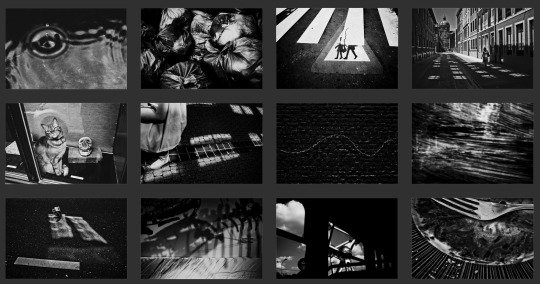
Results using the "rabid dog" method, using a Fujifilm X100, 2014
For this type of photography, the Fujifilm X100 was the tool that instantly clicked with me. The "poorman's Leica" is an apt way to describe what the X100 represented when it came out. I got the original 12mp camera in 2012 as a fun but capable toy to bring along my Nikon D700, until the shutter release button (which also is the on/off switch) broke off in 2020 after one power-up too many. I have since replaced it with a Fuji X-Pro 2 with the XF 18mm F2, 27mm F2.8 and 50mm F2 lenses. To this day, such small Fuji bodies are my tool of choice for this kind of photographic mood (and of course, for family pictures).

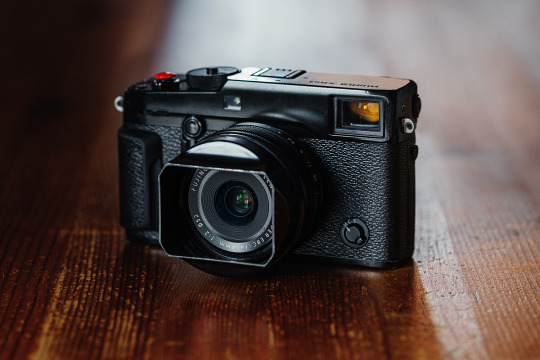
Fuji X100 later replaced by the X-Pro 2 as street photography go-to.
The second photographic process that I tend to naturally gravitate towards stems from my first year of photography school, during which all projects had to be done using film and would have us deal with the whole process (that is to say; shooting, developing, printing, framing, and displaying our work ourselves). It is with nostalgia that I look upon the memories from that time.
There sure is something inherently different in figuring out what to do with the exposures one has left on their film than being able to inconsequentially shoot within two hours three thousand pictures through which you can almost immediately browse. The latter is of course more practical and a welcome technological improvement, but the former brings an unhurried and deliberate focus that I find both refreshing and appealing.
When I think of my strongest recollection of touching the quintessence of the analog experience, the days of using my Mamiya 645 immediately come to mind. Such sluggish, heavy-as-a-couple-bricks box-machines compel one to being careful and purposeful every step of the way. I need that too.
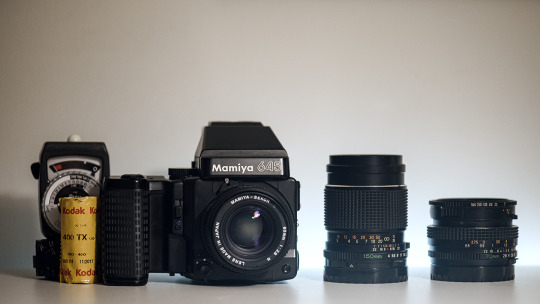
Mamiya 645 Super, since sold to finance GF lenses.
I have for the longest of time considered getting a more serious medium format camera but some quick-math with the price of film, chemicals and photographic paper made me realize that digital medium format was actually much more worth the investment while most definitely retaining some of the core characteristics of its analog counterparts. My love for the film process couldn't hold up against all the advantages of going digital, especially when buying second-hand.
Using medium format always felt like journeying inwards. It has allowed me to spend long hours in daydreaming-states paradoxically laced with an acute awareness of my surroundings. When thinking about medium format, I can recall the soul-washing quality of some of the winds that swept my cheeks while I was standing next to the tripod waiting for the exposure of the 50iso film to finish.
States of contemplation. Another kind of active meditation?
Of course, any camera can provide this type of feeling, but of all of the digital cameras available, medium format is the one type that will weigh you down the most and dictate the pace you work at.
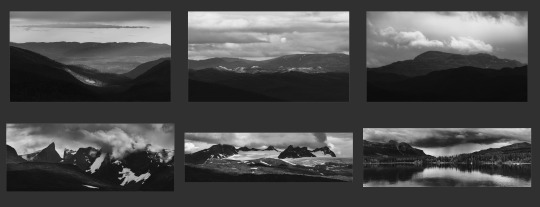
Telepanoramas created with the Fujifilm GFX 50R
Notice how these two ideas are almost the ends of a spectrum?
The first one is nervous and agitated, highly reactive, while the other is composed, meticulous and invites introspective fugue-states, yet they both share one vital element in the way that I approach them in that they take the practical considerations out of the picture to leave more space for what is going on within me.
The setting up of the camera or lack thereof becomes an excuse for something else. Maybe it isn't a surprise, that my adhd-ridden brain experiences this inexorable attraction for both these approaches. For they are in essence, two sides of the same coin, with each side matching different, specific and fluctuating needs.
Let's dive in!
After selling my DSLRs, I started looking for a good second-hand candidate. After a month or so, I found a barely used GFX 50R sold with a 50mm 3.5, a couple additional batteries and an L-bracket to boot. The price was rather attractive for the bundle, so it seemed like the time to take the leap. After a short but excruciating wait for the package to arrive, I finally was able to join the larger-than-35mm-sensor club.
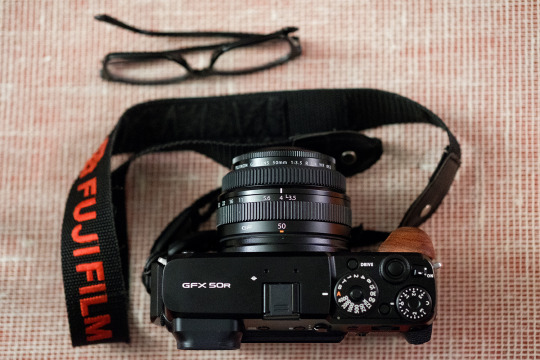
How it started
My first few months with the camera had me immediately blown away by the difference in output. The higher resolution and the sensor's qualities made the (very much existing) noise hardly noticeable when downsized to small printing or screen-viewing sizes. What also immediately struck me, was the looks of the images the camera produced. Images taken with the GFX feel more "3D" to me. It is a very peculiar and hard to describe feeling. I suspect it is a combination of factors; the depth of field of the larger sensor and the very smooth transitions between what's in focus and what is not that it permits, the colour depth, and the quality of the optics. I've seen many Youtube reviews, read forum threads or been in discussions on Discord about GFX cameras where people (who more often than not don't own one) will maintain that these qualities don't exist at all. After a year in the system I can confidently state that they're wrong.
I can't really put my finger on what causes these differences as I am not as tech-savvy as I could be, but it is still clear as day. To use a pretty apt analogy, I would say that the difference between full-frame and (crop) medium format is akin to the difference between aps-c and full-frame cameras. Are they deal-breaking? Not necessarily. For some people they can be. Are they noticeable? Definitely. It is especially funny to me to see medium format cameras being dismissed by such a many full-frame shooter who at the same time, is constantly bashing aps-c sensors.

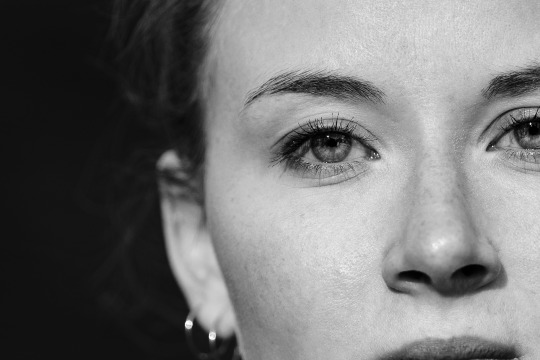
Don't you love to pixel-peep? Omnomnom (imagine with 102mp!)
This being said, I will always fully stand by the statement that full-frame cameras are the more sensible choice as they are better all-rounders by design. High-res cameras like Sony's A7RV or equivalent are also better high-iso performers than the aging IMX161 sensor that the GFX 50 series uses, which sees its operational limit at around 6400iso (but the GFX 100 would be another matter entirely). A top-tier full-frame camera is evidently more practical, lighter and cheaper without any deal-breaking image quality difference to what the medium format niche can offer. When all costs are factored in, the choice would seem self-evident. If you consider medium format, it should be understood that you know this before committing to any bigboy sensor. Or don't heed this and make people who buy second hand happy, as GFX gear loses almost one third of its value once it hits the second hand market (a consequence of too many people jumping on the medium format bandwagon only to realise — way too late — that it wasn't for them).
Are we cooking yet?
I need to talk about the GFX's files for a little bit; I'm a raw shooter only — which hopefully you'd have guessed — (in my opinion anyone buying into a medium format to shoot jpeg must have cognitive issues or too much money, or possibly both) and I have to say that when I opened the raw files to give the sliders their very first +100/-100 or +3/+4 EV from base iso (or any combination of these) I was utterly floored by how well the files could handle such an ungodly beating.
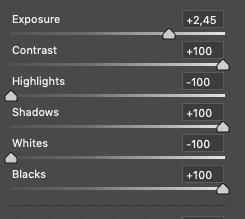
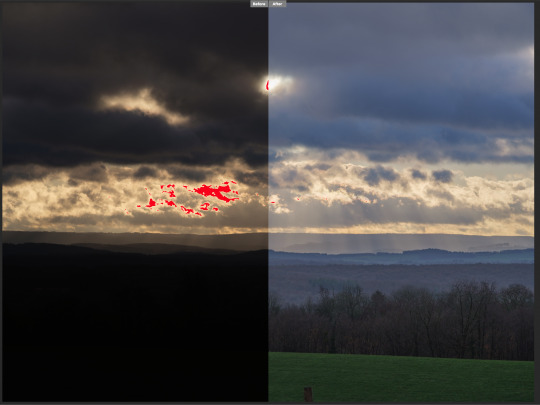
This isn't a joke, I promise.
This type of camera makes the slider memes come true, to a point where for the first few months, my ability to edit properly was severely impaired by the glee I experienced while pushing everything way too far. I believe it is not an uncommon symptom at the start of a medium format journey. It takes a while to come back from that and simply be able to tell yourself "ok here, maybe less dynamic range would be a good edit". I'm getting better at this as I consciously try to avoid overcooking.
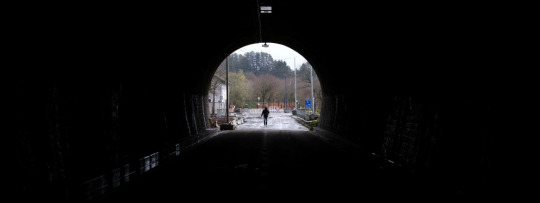
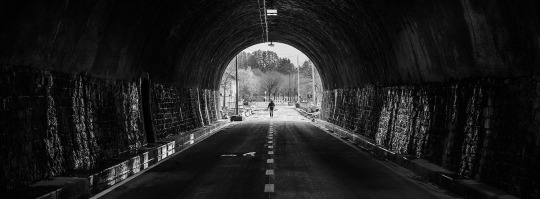
Clean recovery? Can do!
On the image-taking side of things, the major change for me with regards to file-handling is that I'm almost systematically exposing for highlights now. Adding 3EV and boosting shadows in post when shooting at low iso is inconsequential in terms of image quality as there won't be any visible noise whatsoever on the output, unlike my aps-c cameras that will show noise even at base iso. Similarly to many other aspects medium format manages well, this is something I got used to very quickly.
To adapt or to not adapt, that was the question, here's my answer:
At first, I tried adapting my old Mamiya 645 lenses to the 50R. It was useful in the sense that it allowed me to enjoy different fields of view at no cost but it quickly felt like a plaster on a wooden leg. I'm not someone who enjoys the manual focusing as a default and I've grown more and more intolerant of the optical flaws of older lenses as time went by. I realised that it wasn't a viable long term solution for me and quickly chose to sell all my Mamiya cameras and lenses to finance native glass for the GFX.
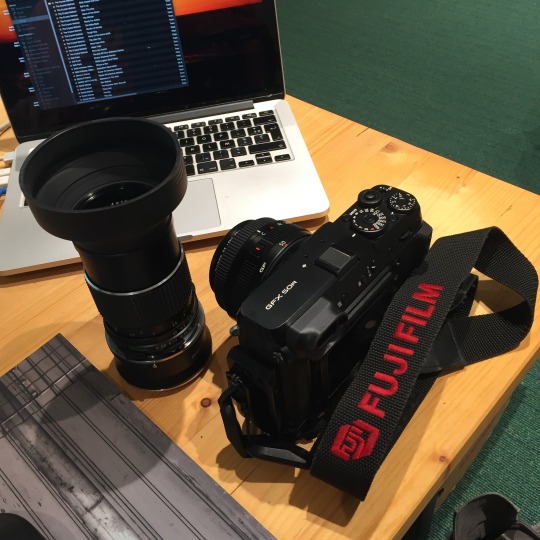
My experience adapting? It was alright but not at all ideal.
Which lenses then?
Getting into the GFX system I promised myself I would make no compromise whatsoever on optical quality and directly aimed for the 250mm F4 (mainly for tele-landscapes) and 110mm F2 (mainly for portraits). The grind felt long but it really wasn't, as I managed to secure both lenses from the second hand market within 6 months. It is only later that I added the 35-70mm "kit" lens to my arsenal to fill the wide-angle gap I had. As I seldom feel the need to shoot wider than short-tele fields of views, this is more of a lens of convenience.
The difference between adapting older lenses and using native glass was night and day to me. Two things made this the better choice in my view: first, I've been actively seeking the "clinical" quality of modern optics. I do not care much for the "character" of older lenses especially not if the word is used to help one overlook a lens' unforgivable flaws. Second, while there sure are lenses worth adapting out there, this come at a cost for the adapting to be worth it (the cost of an AF-capable adapter and of course the cost of the lenses themselves) which I saw as a waste of my limited resources. I told myself I wasn't going to make compromises, remember?
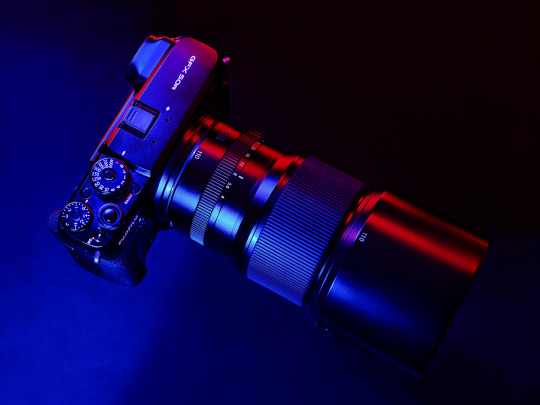
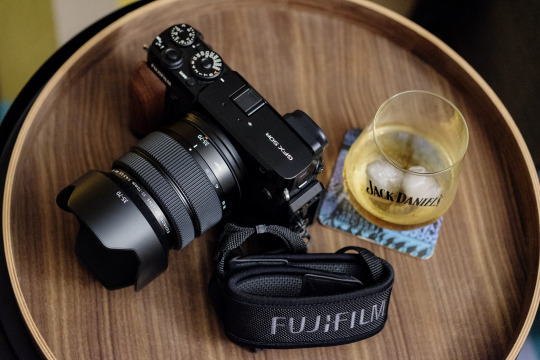
One year after switching, I am now knee-deep into the system, having sold most of my Nikon gear as well as my Mamiya medium format film-cameras to acquire some of the incredibly hard to resist GF lenses.
After a year of transforming a heap of dormant gear and side-gig revenue into new lenses, I also noticed that the representation I had about the worth of money also changed radically when gear was concerned.
A little over a year ago, an XF lens priced 800€ definitely seemed like a steep investment I'd try to find alternative choices for. Nowadays, 800€ is a mere budget lens in my mind. Seeing the price tags of GF lenses doesn't make my head spin anymore and this is somewhat worrisome for the thrifty Dutchman living in the back of my brain.
With the announcement of the 500mm F5.6 lens being in development (a focal length I definitely miss from my Nikon days, I'm a sucker for ultra-telephoto landscape photography), I fear I will manage to push my monetary boundaries further back yet, which I will help achieve by selling my X-T3 video-oriented kit.
APS-C: you're dead to me.
An unforeseen consequence of my GFX switch was that my aps-c cameras were pretty much relegated to the bottom gear drawer and seldom used barring a few notable exceptions (such as a wedding gig) where the need for its autofocusing speed was greater than the need for image and file quality.
To reuse the analogy I made earlier; my X-Pro 2 and X-T3 have become to me what a micro-four-thirds camera would be to a full-frame camera user. Getting into Fujifilm's medium format system prompted me to think about how I use my cameras and to what end. The realisation that there is a clear split in my photographic approaches I evoked at the very beginning of this article is the result of that thought process.
Although I will sell my X-T3 because it feels superfluous and I want to stop my video gigs completely, (and because my need for GFX lens money is still great), I would never part with my X-Pro 2 nor the few XF lenses that I have as they serve a totally different purpose to that of the GFX's.
Having a compact, fast, discreet yet still capable camera that can be casually put into a pocket is an advantage that I would be a fool to part with. The X-Pro is a more practical choice for street-photography, documentary in less-than-favourable conditions, as well as for family pictures, when packing a brick of a camera and two bricks worth of lenses for a walk in the park in suboptimal weather would be met with a tired roll-eye from my spouse.
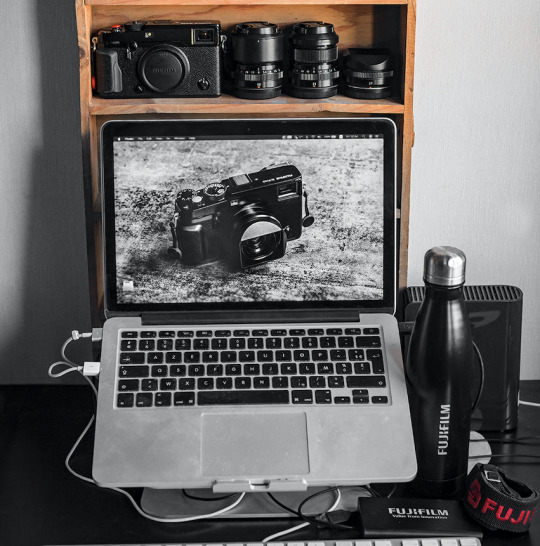
My dear X-Pro, I'm Never Ever Gonna Give You Up
Of course there have been many occasions for which I have chosen to take the challenge and went into these situations with the GFX. However, I wouldn't want the GFX to be the only option at my disposal in such cases.
For example, during the last wedding I shot, when the dining room got darker and the guests started moving around a lot (and dancing), the switch to aps-c cameras was absolutely necessary because of how difficult it was to consistently get acceptable results in poor light and with subjects making erratic movements. When you are held under a result-delivering imperative, you have to be able to honour it.
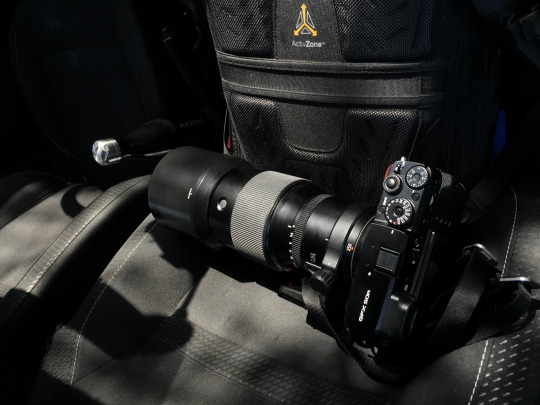
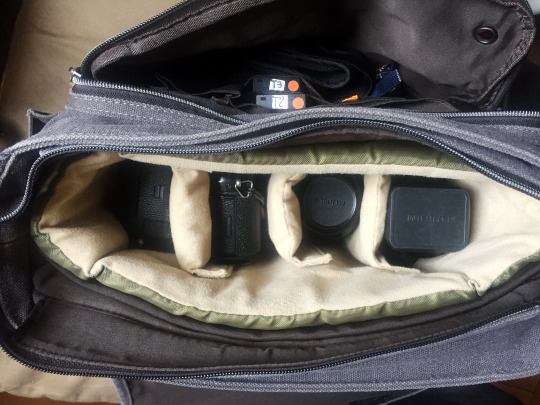
Packing a Fuji GF or Fuji X kit can be a slightly different experience
"Megapickles don't matter!"
This was an idea that I lived by just a few years ago. I changed my mind. I still believe that megapixels don't matter when you don't have them. Just like one should shoot with the camera one has / is able to afford. It doesn't matter in the grand scheme of things but all these technical niceties just make one's life more comfortable. Cropping, denoising through file reduction algorithms, or enjoying detail endlessly because one can, these are just the icing on the cake. I just happen to like my cakes with more icing than cake now.
Regarding resolution specifically, it's been another area in which there seems to be no possible coming back. Nowadays, every time a manufacturer announces a new camera and I discover they plan to fit it with a 24MP sensor I dismiss the information entirely. It doesn't register anymore. 32-36 is the new 24 in my mind now and it's sometimes difficult to come back from those expectations.
This being said I have no issue using lower resolution aps-c that I own and could perhaps even have fun with a X-Pro 1 because then the output quality wouldn't be my prime concern. It is only concerning new releases that my interest dips firmly for "low" MP cameras.
Did I tell you that medium format AF sucks?
Before I conclude this one-year review, let me hammer this point in with a two-handed mace; it can't be understated, especially for the GFX 50 series which uses contrast detection — the autofocus will throw you back to the early 2000s. Be ready to be stuck on single point, single AF mode because that's the only thing that will be consistent enough.
Then let's not forget other factors that add to the bad and make it worse; the shutter lag is half a second, the sensor readout speed is 1/4th of a second, and the time the shutter takes to clear the large sensor in combination with the camera's high resolution means you'll need higher shutter speeds in order to get rid of motion blur when shooting handheld (count about one stop faster than usual). Those would be valid reasons as to why a less niche camera system makes more sense for a lot of people.
The final comment:
Despite its sometimes dramatic drawbacks, I definitely have found the pleasure I sought when I originated this system switch. The change and the adapting my process is engaging and makes me think more about what I do, what I use, when and why. This is a win on its own.
All in all I feel like I am still at the very start of my journey though I've had the opportunity to test my GFX 50R in a wide array of situations in the past year (portrait, landscape, documentary) it seems like the way forward is clear and also opened for plunging deeper into this incredibly fun (but needlessly expensive) rabbit hole.
The upcoming 500mm, the prospect of finding an original GFX 100 (with its weirdly appealing tiltable EVF) are ideas that will — for the foreseeable future — definitely keep pulling me back in (and emptying my pockets).
Fun! Fun! Fun!
8 notes
·
View notes
Note
so what equipment do you use for your IR work?
I've got two IR converted cameras & one I stole from my girlfriend.
For 590nm shots, my most common IR shot, I use a Panasonic GX85 & usually a Panasonic 25mm f/1.7 lens. This camera was stolen from my girlfriend. This is a dream camera + lens combo. The lens is soooo good & pretty cheap! Love this setup.
For 720nm shots I use a Panasonic GH3, usually with the same lens. This camera is super nice and really comfortable. However, 720nm is a pretty limiting IR conversion. The colors are pretty muted. I'd stick to black and white with this conversion in the future.
For IR Chrome shots I use a full spectrum converted Fujifilm X-E1. I got this camera cheap because its original owner had ripped the IR filter off the sensor himself and broke the mount contacts in the process. So, no auto focus and no electronically controlled lenses on this one. It's pretty limiting but the results are cool.
For the full spectrum camera, I use a Kolari Vision IR Chrome Lite clip in filter to achieve the IR Chrome look. One huge benefit of full spectrum camera is buying filters to achieve each conversion type. So, I'll probably pick up 590nm and 720nm filters in the future, maybe more.
Since it's IR season, I'm thinking of converting a good Fujifilm camera to full spectrum so I can take advantage of all of my lenses. We'll see!
4 notes
·
View notes
Text

Mark T Lutz, Florida FUJIFILM X-T3
Wrist strap, lug-mount Regular Dark brown leather, Dark red wrapping cord
Quality is great, detail is excellent.
3 notes
·
View notes
Text
[ Amazon, Pre-order ] Sigma 16-300mm f/3.5-6.7 DC OS Contemporary Lens for Fujifilm X Mount
Amazon US ( Amazon.com ) has now listed the Sigma 16-300mm f/3.5-6.7 DC OS Contemporary Lens for Fujifilm X Mount online for pre-order. The price in the US starts at $699.00. The UPC of this lens is 198983887753. This lens is also available in Canon RF Mount, Sony E Mount, and Leica L Mount. Pre-order from Amazon. This groundbreaking lens boasts an 18.8x zoom ratio, the highest for an APS-C…
0 notes
Text
Fujifilm X-S20 Review
Die stilvolle spiegellose Fujifilm X-S20 ($1.299.95, nur Gehäuse) Kamera bringt Fujis geliebte Farbwissenschaft in ein Mainstream-Gehäuse mit allen Bedienelementen, die Schöpfer sich wünschen können. Es verfügt über denselben Bildsensor wie sein Vorgänger, die ausgezeichnete X-S10, aber ein verbesserter Prozessor verbessert Autofokus- und Videofunktionen, während ein kräftigerer Akku die Laufzeiten deutlich verlängert. Diese Verbesserungen machen die X-S20 zu einer überzeugenden Kamera für Fotohobbyisten und Vlogger gleichermaßen und verdienen die Kamera unseren Editors' Choice Award.
Die Fujifilm X-S20 ist das zweite Modell seiner Linie, nach der X-S10 ab 2020. Die neue Ausgabe folgt dem Original im Konzept; Es verzichtet auf Fujis charakteristische Zifferblatt-gesteuerte Belichtungssteuerung zugunsten eines bekannten PASM-Zifferblattes, zentriert den Sucher hinter dem Objektiv und verfügt über ein ausschwenkbares LCD für Selfies und Vlogs.
Der X-S20 verwendet denselben 26MP X-Trans BSI CMOS Sensor wie sein Vorgänger, kombiniert ihn jedoch mit einem aktualisierten Bildprozessor für besseren Autofokus (mit Motiverkennung) und 10-Bit 4K60 Video. Das Gehäuse ist etwas größer als zuvor, aber mit 3,4 by 5,0 by 2,6 Zoll (HWD) bleibt es eine der kompaktesten Kameras mit 5-Achsen-Bildstabilisierung.
Auch die Baumaterialien sind hochwertig. Fuji verkauft dieses Modell nur in schwarz, aber das Äußere besteht aus einer robusten Magnesiumschale mit Kunstlederfolie. Es wiegt etwa 1,1 Pfund ohne Objektiv, was es zu einer guten Passform für Reisen macht, obwohl es einige Punkte für das Überspringen von Staub und Spritzschutz verliert, die Konkurrenten wie die Sony a6700 ($1,400) bieten.
Fuji integriert einen Pop-up-Blitz im Gehäuse, etwas, das es normalerweise für Einsteiger- oder Mittelklasse-Kameras reserviert. Es reicht nicht aus, um einen dunklen Raum zu beleuchten, ist aber nützlich, um Schatten in einigen Szenarien zu füllen. Was Objektive anbelangt, bietet Fuji eine vollständige Reihe von X-Mount-Optionen, ein Vorteil der zehnjährigen Lebensdauer des Systems. Das Unternehmen hat auch ältere Einträge mit modernem Design aktualisiert – die XF 33mm F1.4 und XF 56mm F1.2 WR sind gute Beispiele.
Es stehen zwei Kit-Optionen zur Verfügung. Sie können die X-S20 mit dem kleinen XC 15-45mm Power Zoom für $1.399.95 bekommen, nur $100 mehr als der Body-only Preis. Für $1.699.95 bekommt man die Kamera mit dem XF 18-55mm F2.8-4 R, einem älteren Objektiv, das auch heute noch gute Arbeit leistet.
Leider gibt es keine Kit-Option für das neuere XF 16-80mm F4 R OIS WR ($799.95), daher müssen Sie dafür das volle Boot bezahlen, wenn Sie Fujis bestes Starterzoom wollen. Das Tamron 17-70mm F2.8 ist zum gleichen Preis erhältlich,also zählen Sie es nicht aus, wenn Sie eine F2.8-Blende der optischen Stabilisierung bevorzugen.
Das Gehäuse der X-S20 ähnelt dem Original X-S10, aber ein größerer Griff und der zentrierte Sucher erleichtern die Verwendung schwererer Objektive – ich habe es genossen, das Tamron 150-500mm mit der Kamera zu kombinieren. Dank des 8-Wege-Fokussteuerungssticks ist das X-S20 auch besser geeignet für Action- und Wildobjekte, die diese Objektive erfassen, im Vergleich zu anderen in dieser Klasse, die es weglassen, insbesondere Sony a6700 und Nikon Z 50.
0 notes
Text
Fujifilm X Users: Get This Lens
It’s seriously one of the best zoom lenses for Fujifilm X mount. The Tamron Holiday Deals are here. Amongst them are savings on the Tamron 35-150mm f2-2.8 lens for Nikon Z and Sony E mount. This is widely considered their best lens, and often said to be one of the best lenses made in the past few years. But on top of that, there are lots of other savings available on nearly all their lens…
0 notes
Text
Film Test: CatLABS X Film 80 II - Fujifilm GA645 Professional.
Film Test: CatLABS X Film 80 II – Fujifilm GA645 Professional. So I walk into my local camera shop to complete a lens mount brand flip. More on that later. As I restocked film Chris recommended a new arrival at the store. CatLABS X Film 80 II. I missed the eversion I so here we are. I bought two rolls mainly because I was concerned of a repeat of the first B&W CatLabs film I tried. X Film 320. I…
0 notes
Text
Meike 55mm f/1.4 (x-mount)Lens Review
Background Since getting the Fujifilm X-A3, I’ve been on the search for some inexpensive lens to go with it. First was the Viltrox 33mm f/1.4 that I got with the camera. Next, I wanted to get something with a little more reach. Saw some reviews for the Meike 55mm f/1.4 and thought I’d give it a try. Even more awesome than the MSRP price is getting one during Amazon Prime Day for even…

View On WordPress
0 notes
Text
Podcast Equipment for Beginners
You don’t need to invest in a pricey podcast equipment bundle to achieve high-quality audio. Many successful podcasts use a simple setup.
Let’s explore key factors when choosing a podcast, followed by our top equipment recommendations.
Develop a podcast concept. Define your goals. Pick a podcast theme or topic. It’s important to know your why, even if it’s just to have fun with friends. Some good reasons for starting a podcast are:
To generate leads for a business
To be recognized as an industry leader
To share an important message

Microphones
Samson Q2U ($70) Versatile and budget-friendly dynamic microphone offers both XLR and USB connections, making it perfect for beginners.
PodMic ($100) Durable dynamic microphone designed for podcasting, delivering broadcast-quality audio with minimal background noise.
Shure SM7B ($400) Professional-grade dynamic microphone known for its warm, smooth sound, ideal for high-quality podcast recordings.
Microphone Types
Dynamic MicrophonesLess sensitive to background noise, making them ideal for podcasting in non-studio environments.
Condenser MicrophonesMore sensitive and capture a broader frequency range, better suited for music recording than spoken words.
Audio Interfaces
PreSonus Revelator io24 ($100) Features studio-quality sound effects, Bluetooth connectivity, and dual headphone outputs, making it a powerful tool for podcasters.
Focusrite Scarlett 2i2 ($160) Offers high-quality preamps, versatile inputs, and “Air” mode for enhanced vocal clarity, perfect for capturing detailed audio.
RODECaster Pro ($600) An all-in-one podcast production studio with multiple inputs, sound pads, and easy-to-use controls for both beginners and professionals.
Cameras
Fujifilm X-S20 ($1,299) A versatile camera with 6.2K video capabilities and dual audio jacks, ideal for podcasters needing high-quality visuals and audio monitoring.
Canon EOS R8 ($1,499) A full-frame camera with a 24-megapixel sensor, offering excellent 4K video quality and portability for on-the-go podcasting.
Sony ZV-E1 ($2,198) A top-tier camera with AI-based Auto Framing and a full-frame sensor, designed for high-end podcasting with multiple hosts.
Nikon Z30 ($656) A budget-friendly option with customizable buttons and recording indicators, great for content creators working in front of the camera.
Sony ZV-E10 ($800) A cost-effective APSC sensor camera, ideal for multi-camera podcast setups without sacrificing quality.
Sony ZV1 Mark II ($898) A compact and portable camera with a built-in lens, perfect for podcasters who prioritize mobility and ease of use.
Accessories
RODE PSA1 Boom Arm ($120) A durable and flexible boom arm that provides stable microphone positioning for professional podcast setups.
Shock Mount ($35–50) Reduces vibrations and noise, ensuring cleaner audio recordings by isolating the microphone from physical interference.
Foam Ball ($6–10) A simple yet effective windscreen that reduces plosive sounds and protects the microphone from dust and moisture.
I have described the complete equipment bundle in detail. To know more about features, functionalities, pros and cons of these accessories, go through my blog soundorp.com/equipments.
0 notes
Text
Erstkontakt: Samyang 12mm F2 AF – Street-Fotografie mit dem Ultraweitwinkel?
Wer kennt das nicht? Der Postbote klingelt endlich und da ist es: Das neue „Spielzeug“! Hier möchte ich euch über meine ersten Erfahrungen mit dem Samyang 12mm F2 AF am Fujifilm X-Mount berichten – in einem etwas ungewöhnlichem Setting für ein Ultraweitwinkel-Objektiv: Streetfotografie. Ich habe es auch dieses Mal mit einem kleinen Video versucht – so langsam werde ich warm mit YouTube und dem…
0 notes
Text
محول مثبت على عدسة ، لعدسة Praktica B PB إلى Fuji FX Fujifilm X-Mount جسم كاميرا FX ، جودة عالية
اشتر من الصين مع توصيل مجاني محول مثبت على عدسة ، لعدسة Praktica B PB إلى Fuji FX Fujifilm X-Mount جسم كاميرا FX ، جودة عالية
محول مثبت على عدسة ، لعدسة Praktica B PB إلى Fuji FX Fujifilm X-Mount جسم كاميرا FX ، جودة عالية

الوصف:
1. أولاً ، قم بتعيينها في قائمة الكاميرا: قم بتشغيل “بدون عدسة” ، ويمكنك استخدام حلقة المحول.
2. استخدام شاشات الكريستال السائل للتركيز ، كلها تركز يدويًا.
3. يمكن تحقيق وظيفة التركيز باستخدام وظيفة تكبير MF و 7 أو 14 مرة وظيفة تكبير.
4. استخدام م أو وضع لاطلاق النار.
5. التركيز على مسافة لا حصر لها.
يمنحك هذا المحول القدرة على استخدام العدسة الرئيسية التي لا يمكن استبدالها ويوفر عليك تكلفة شراء عدسات جديدة
المحولات مصنوعة بدقة لضمان الملاءمة المثالية.
يسمح بالتركيز اللانهائي.
يتم ضبط التحكم في الحجاب الحاجز للعدسة يدويًا.
عالية الجودة والمدمجة.
مادة: مصنوعة من النحاس والألومنيوم
اللون: أسود
تسمح ��دسات Praktica B المركبة المستخدمة في جسم كاميرا Fujifilm X series.
متوافق مع:
تشمل كاميرا Fujifilm: Fuji ، من ؟
من من ؟ ؟ ؟ ؟ ؟ ؟ ؟ ؟ ؟ ؟ ؟ ؟ ؟ ؟ ؟ ؟ ؟ ؟ ؟ ؟ ؟ ؟ ؟ ؟ ؟ ؟
X20 ، X30 ، XF1 ، XQ1 ، XQ2 وما إلى ذلك.
Plackage inlclude:
محول عدسة 1 ×




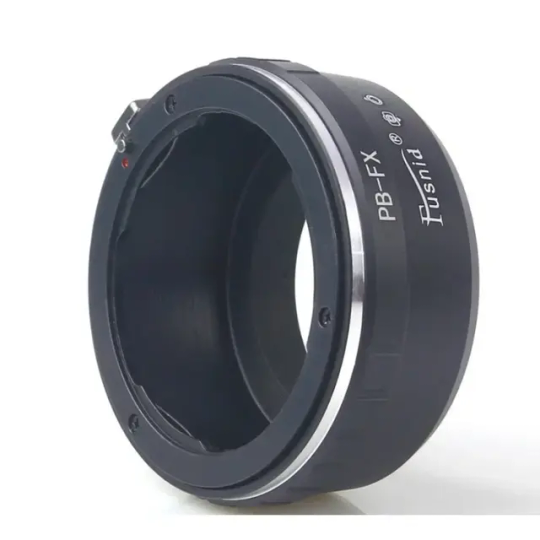

0 notes
Text
Top 5 Cameras for Wedding Photography: Advantages and Disadvantages
1. Canon EOS R5 Advantages: 1. High Resolution: The 45MP sensor delivers incredibly detailed images, perfect for large prints and cropping without losing quality. 2. Advanced Autofocus: Canon's Dual Pixel CMOS AF II provides fast and accurate autofocus, even in challenging lighting conditions, ensuring you capture every critical moment. 3. 8K Video: The ability to shoot in 8K resolution allows for high-quality video production and the ability to extract high-resolution stills. 4. In-Body Image Stabilisation (IBIS): The 5-axis IBIS helps in reducing camera shake, enabling sharp images even at slower shutter speeds. 5. Versatile Lens Options: The RF mount offers a wide range of high-quality lenses tailored for professional use. Disadvantages: 1. Overheating Issues: Extended video recording, especially in 8K, can cause overheating, which might limit shooting time. 2. High Cost: The advanced features come at a premium price, which might be a significant investment for some photographers. 3. Large File Sizes: The high-resolution images and 8K videos result in large file sizes, requiring significant storage capacity and powerful editing hardware. 2. Nikon Z7 II Advantages: 1. Excellent Image Quality: The 45.7MP sensor provides superb dynamic range and detail, crucial for wedding photography. 2. Improved Autofocus: Enhanced AF performance with eye-detection ensures sharp focus on subjects, even in low light. 3. Dual Card Slots: Supports CFexpress/XQD and SD cards, offering flexibility and redundancy, important for wedding shoots. 4. Robust Build: Weather-sealed body ensures reliability in various environmental conditions. 5. User-Friendly Interface: Intuitive controls and a high-resolution electronic viewfinder enhance the shooting experience. Disadvantages: 1. Limited Native Lenses: Although growing, the Z-mount lens lineup is still not as extensive as some competitors. 2. Battery Life: While improved, the battery life could be better for long wedding shoots. 3. Video Capabilities: While solid, the 4K video specs are not as advanced as some competing models. 3. Sony A7R IV Advantages: 1. High Resolution: The 61MP sensor offers extraordinary detail and resolution, ideal for large prints and extensive cropping. 2. Real-Time Tracking and Eye AF: Sony's autofocus system is among the best, ensuring precise focus on subjects' eyes, even in motion. 3. Dynamic Range: Exceptional dynamic range captures fine details in both highlights and shadows. 4. Versatile Lens Ecosystem: E-mount system provides access to a vast array of lenses from Sony and third-party manufacturers. 5. Compact and Lightweight: Despite its high specs, the A7R IV remains relatively compact and lightweight, beneficial for long shoots. Disadvantages: 1. File Management: The massive 61MP files can be cumbersome to manage, requiring substantial storage and processing power. 2. Complex Menu System: The extensive features lead to a complex menu system that can be overwhelming for new users. 3. Battery Life: Intensive use, especially with high-resolution images, can drain the battery quickly. 4. Fujifilm X-T4 Advantages: 1. Colour Science: Renowned for its colour reproduction and film simulations, delivering beautiful, vibrant images straight out of the camera. 2. IBIS: In-body stabilisation ensures sharp images, even in challenging conditions. 3. Video Features: Capable of 4K/60p video recording, providing high-quality video performance alongside stills. 4. Build Quality: Robust, weather-sealed body ensures durability and reliability. 5. Compact and Lightweight: The APS-C sensor allows for a more compact and lighter camera body, making it easier to handle during long events. Disadvantages: 1. APS-C Sensor: While excellent, it doesn’t match the full-frame sensors in terms of depth of field and low-light performance. 2. Battery Life: Although improved, the battery life still falls short compared to some full-frame counterparts. 3. Limited Lens Selection: While Fujifilm offers a range of high-quality lenses, the selection is more limited compared to full-frame systems. 5. Canon EOS 5D Mark IV Advantages: 1. Proven Reliability: The 5D series has a long-standing reputation for durability and performance, trusted by professionals worldwide. 2. Image Quality: The 30.4MP full-frame sensor delivers excellent image quality with good dynamic range and colour accuracy. 3. Versatile: Suitable for both stills and video, with 4K video capability and robust performance in various shooting conditions. 4. Lens Compatibility: Access to a wide range of EF lenses, providing flexibility and options for different shooting styles. 5. Ergonomics: Comfortable and intuitive to use, with a well-thought-out control layout. Disadvantages: 1. Weight and Size: Being a DSLR, it is bulkier and heavier compared to mirrorless options. 2. Single CF Card Slot: Unlike newer models with dual card slots, the single CF card slot could be a drawback for some photographers. 3. Outdated Tech: While still a strong performer, some of its features and specs are behind the latest mirrorless offerings. Each of these cameras offers unique strengths that can enhance your wedding photography. The choice ultimately depends on your specific needs, budget, and shooting style. Investing in any of these top cameras will provide you with the tools to capture beautiful, timeless wedding photos that your clients will cherish forever. Choosing the Sony for wedding photography has been one of my best decisions. Here's why I love using this camera and why it works perfectly for my needs: Reasons I Choose the Sony A7R IV for Wedding Photography 1. High Resolution - 61MP Sensor: The Sony A7R IV’s 61-megapixel full-frame sensor provides unmatched detail and resolution. This is particularly beneficial for wedding photography, where capturing intricate details like the lace on a wedding dress or textures in floral arrangements is crucial. The high resolution also allows me to crop images significantly without losing quality, which is useful for creating different compositions from a single shot. 2. Exceptional Autofocus - Real-Time Tracking and Eye AF: Sony’s advanced autofocus system ensures sharp focus on my subjects, which is crucial for candid moments and fast-moving scenes typical at weddings. The real-time tracking and eye autofocus (Eye AF) work seamlessly, keeping the bride and groom in sharp focus even when they are moving or in low light conditions. This reliability allows me to concentrate more on composition and creativity. 3. Dynamic Range - Wide Dynamic Range: The A7R IV’s sensor offers excellent dynamic range, capturing details in both highlights and shadows. This is particularly important in wedding photography, where lighting conditions can vary greatly throughout the day. Whether I’m shooting in harsh midday sun or dimly lit receptions, the A7R IV helps me retain detail and colour accuracy. 4. Versatile Lens Ecosystem - E-Mount Lens Compatibility: The A7R IV is part of Sony's E-mount system, giving me access to a vast range of lenses from Sony and third-party manufacturers. This versatility allows me to choose the perfect lenses for different aspects of wedding photography, whether I need a fast prime lens for portraits, a wide-angle lens for group shots, or a telephoto lens for candid moments from a distance. 5. Compact and Lightweight Design - Portability: Despite its high specs, the A7R IV is relatively compact and lightweight compared to many DSLR counterparts. This makes it easier to carry and handle during long wedding shoots, reducing fatigue and allowing me to move more freely to capture the best angles and moments. 6. Professional Video Capabilities - 4K Video Recording: The A7R IV offers high-quality 4K video recording, making it suitable for capturing cinematic wedding videos alongside stills. The ability to shoot high-resolution videos provides flexibility and enhances my offerings to clients who may want both photo and video services. 7. Excellent Low Light Performance - ISO Sensitivity: With a broad ISO range, the A7R IV performs well in low-light situations, common in wedding receptions and evening events. This capability ensures that I can capture clear, noise-free images even in dimly lit environments, allowing me to focus on capturing the ambiance and mood of the event. Conclusion Choosing the Sony A7R IV for wedding photography has been a game-changer for me. Its exceptional image quality, reliable autofocus, and versatile lens options make it a perfect fit for capturing the special moments of a wedding day. The camera’s ability to handle diverse lighting conditions and its compact design make it a powerful tool in my kit. While the large file sizes and battery life are considerations, the benefits far outweigh these drawbacks, making the Sony a top choice for my professional wedding photography needs.
0 notes